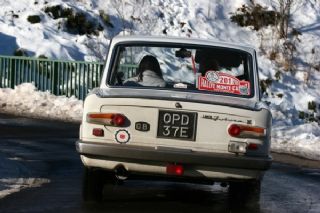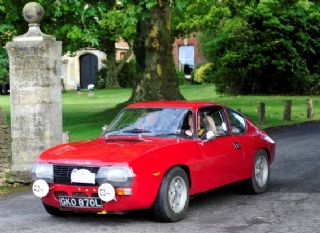Retro-Gnome on the Lancia Fulvia
LET'S GET ONE THING CLEAR, when it comes to rust, the Lancia Fulvia is no worse, and a damn sight better, than a thousand other ‘classics’ built during the sixties and seventies. At this point, owners of Porsche 911s, Mercedes and E-Type Jaguars should be nodding their heads in agreement. It was the later Beta, built from cheap Russian steel, that created this misnomer which resulted in Lancia customers being offered their money back and the Company finally closing shop in the UK. The Fulvia on the other hand, was a petite and delightfully harmonious sports car, brilliantly conceived, immensely strong and a joy to drive. In HF form it was also a prolific rally winner.

Berlina 2C on Rallye Monte-Carlo Historique 2007
The Fulvia range kicked off at the Geneva Show in 1963 with a rather frumpy, 1091cc, 58bhp, four-door Berlina, designed to replace the ageing Appia and provide well-heeled Italian families with an alternative to the common Fiat 1100. The Pietro Castagnero-designed Coupe, using the same V4 twin-overhead-cam engine, but with a healthier 80bhp, arrived in 1965, around the same time as the aero dynamic, all aluminium Sport, better known as the Zagato. By 1968 all Fulvias were uprated to 1300cc.
As early as 1965 the Fulvia Coupe had began its illustrious rally career, and just twelve months later the first HF Squadra Corse-prepared 1.2 HF was homologated under the guidance of Gianni Tonti. This was replaced with the publicly available 101bhp, 1.3 HF in 1967. Trautmann drove the first 1.6 litre car as a prototype on the 1968 Tour de Corse and RAC Rally. This model when produced officially became better known as ‘Fanalone’ (Italian for big headlamps) and, with its direct rally heritage and possible 132bhp, has become the most desirable Fulvia in the range.

Zagato-bodied Sport
At this point it is necessary to understand that everything to do with Lancia is complicated. All the above relates to ‘first’ series models, those created and built by real Lancia engineers with little interference from Fiat who took over the ailing Company in October 1969 when production had dropped to a dismal 37,000 units.
First thing Fiat did was to raid the corporate parts bin and as from 1970 the Berlina, Coupe, HF and Zagato evolved into ‘second’ series cars. Myriad changes took place, common or garden nuts and bolts were standard issue and sadly the delightful four-speed box was replaced with a brash five-speed unit. Not all was bad though, at least the heater now worked as did the all-round disc brakes. The Zagato took on the 1.6 engine while the Fulvia HF continued but lost its competition extras, no aluminium and no oil cooler. However, it still kept the aggressive wide wheels, fat tyres and rally connections, a ‘series’ two even won the 1972 Monte Carlo Rally. The last HF was built in 1973.
.JPG)
HFs and 1.3 Coupe
The final Fulvia, only the standard 1.3 Fulvia Coupe was left in production, and it had now become a ‘third’ series, left the factory in the first week of 1976 when production of the nice-to-drive, but flawed and frail, Beta was in full swing.
Buying a Lancia Fulvia, as with all specialisist cars, demands knowledge and patience. Original, good condition cars still exist, while restoration is no more difficult than that of say, a Mini Cooper S or a Ford Lotus Cortina. Parts are available both here and in Italy, workshop manuals have been reprinted and, with the advent of the Internet, knowledge and encouragement is proffered from across the world.
And talking of the Internet, this is the best place to find Fulvias for sale. But for goodness sake, do the homework before traipsing half way across Europe. Check out matching numbers and remember: it’s easy to build an HF look-a-like out of a plain and simple Coupe.
All Coupes are enjoyable to drive, spacious and economic to run; expect 32-plus to the gallon from a 1.3 along with a genuine 100mph top speed Acceleration is acceptably brisk. Most genuine HFs are ‘second’ series; they do not, as standard, have yellow-painted cam covers or oil coolers, but they do have different distributors and an oil temperature gauge instead of a clock on the passenger side of the dashboard. Also, the suspension is carried over from the early cars and the ultra wide 6J wheels only fit the HF. They should be described on the log book as a 1.6 HF Lusso, which refers to the extras fitted by the factory to make occupants more comfortable. Of course it was possible, for competition use, to order a basic, no frills HF.
Well, I did say at the beginning it was complicated.
Fulvias for sale at:
www.classiccarsforsale.co.uk
www.omicron.uk.com







